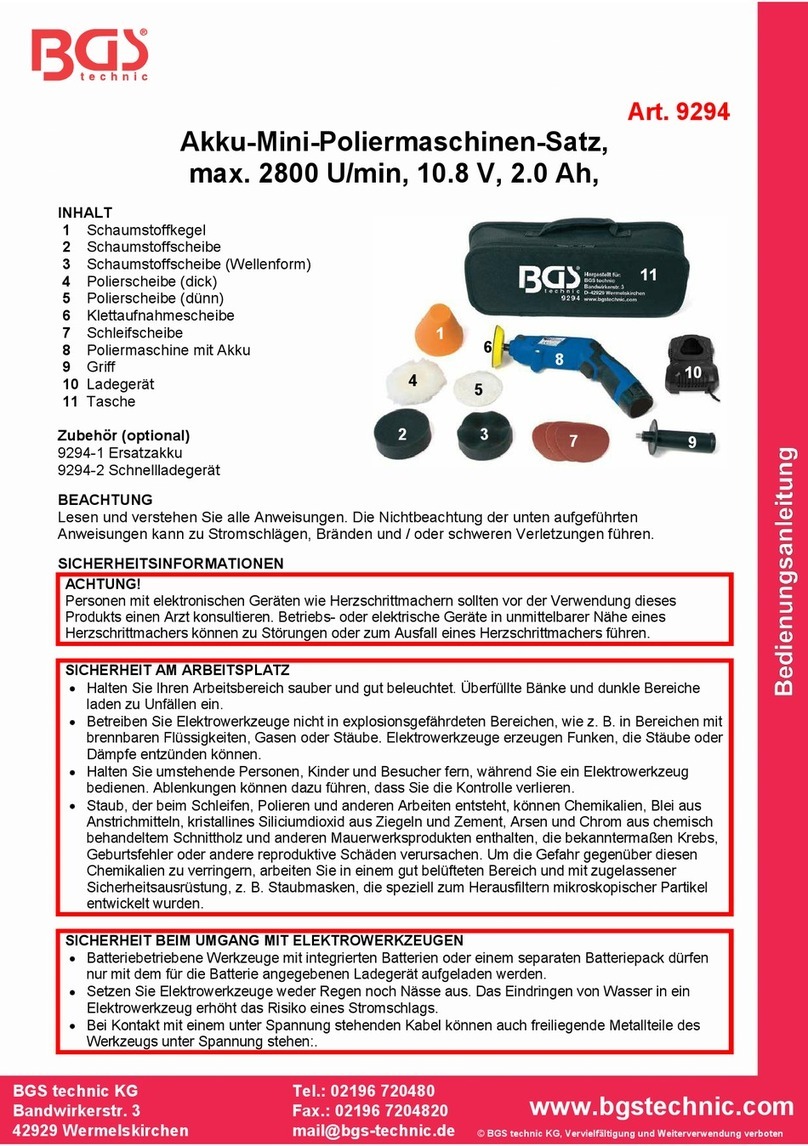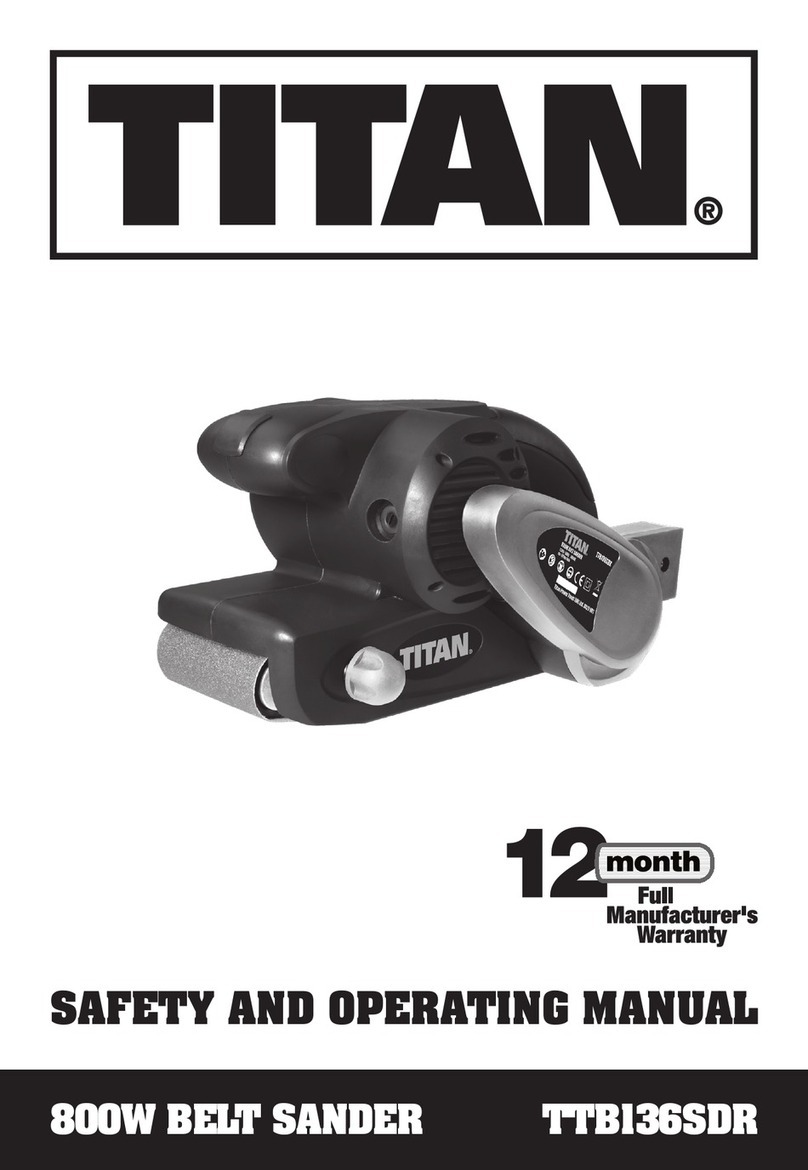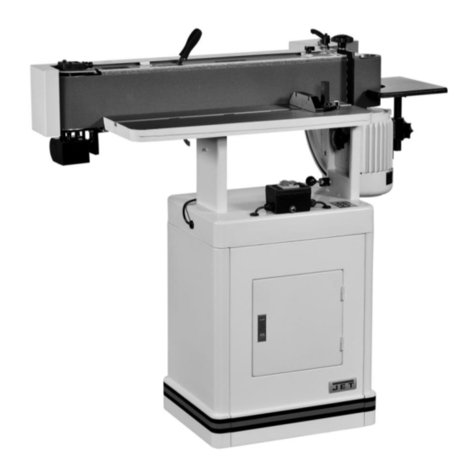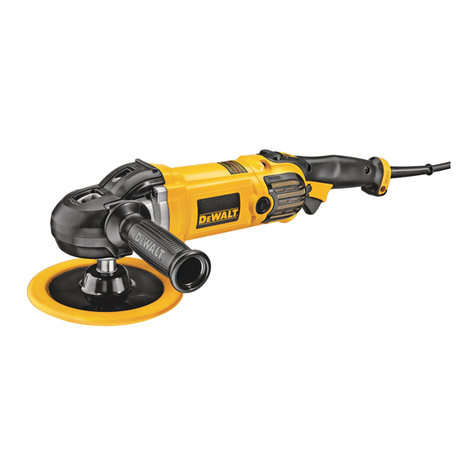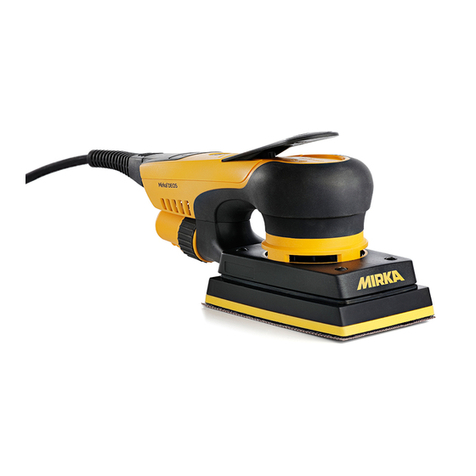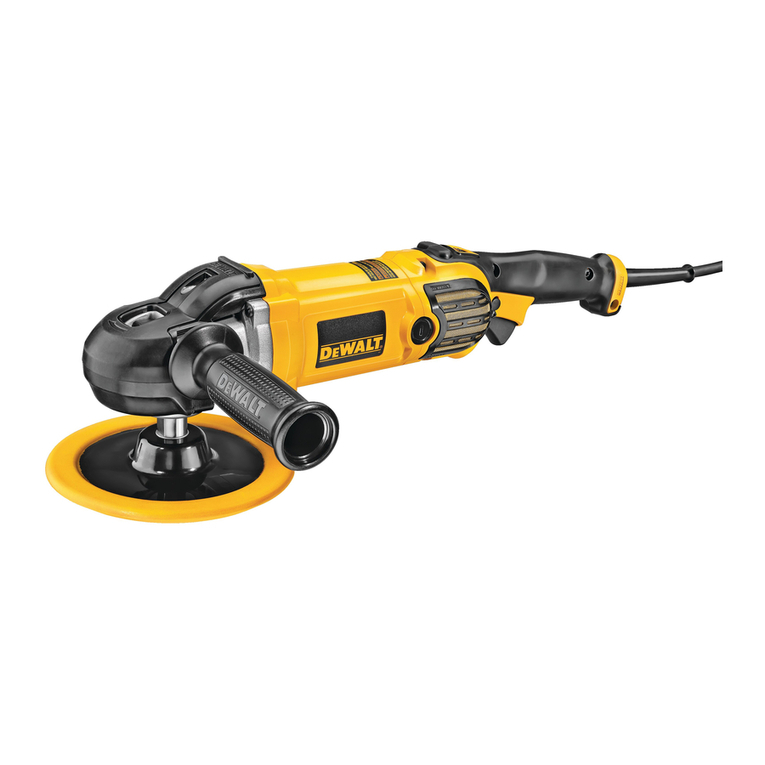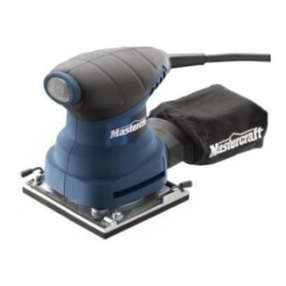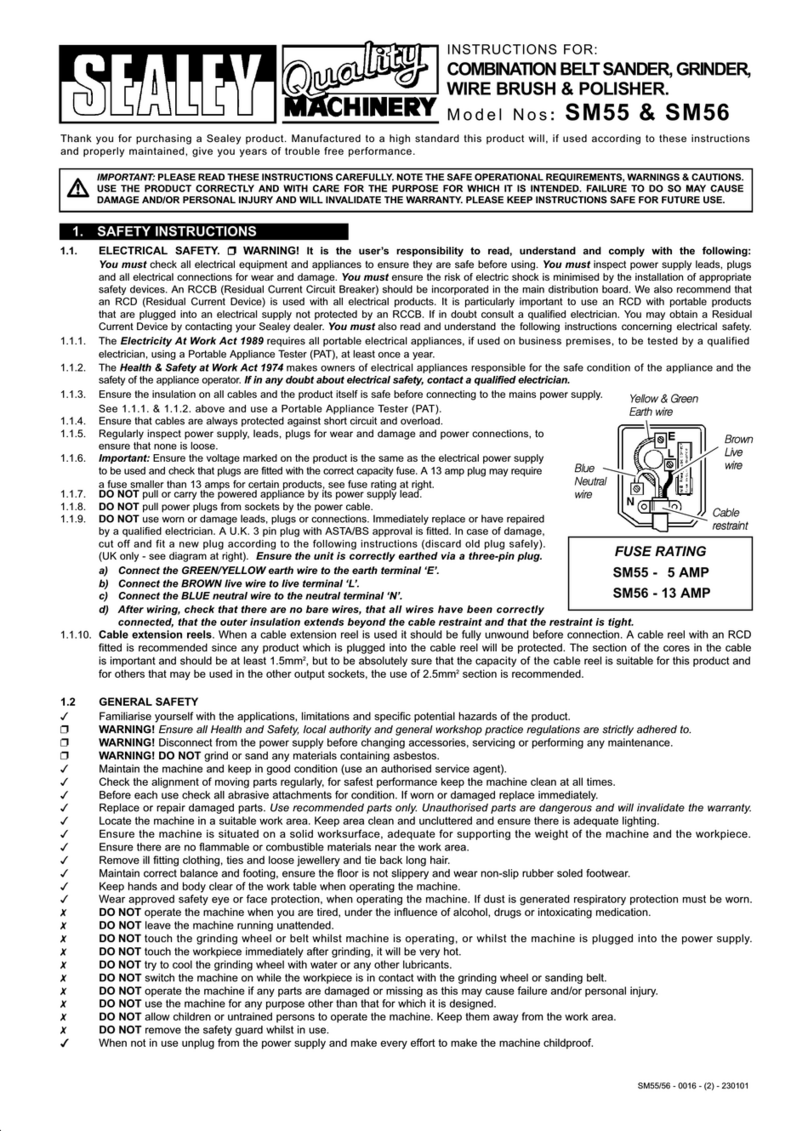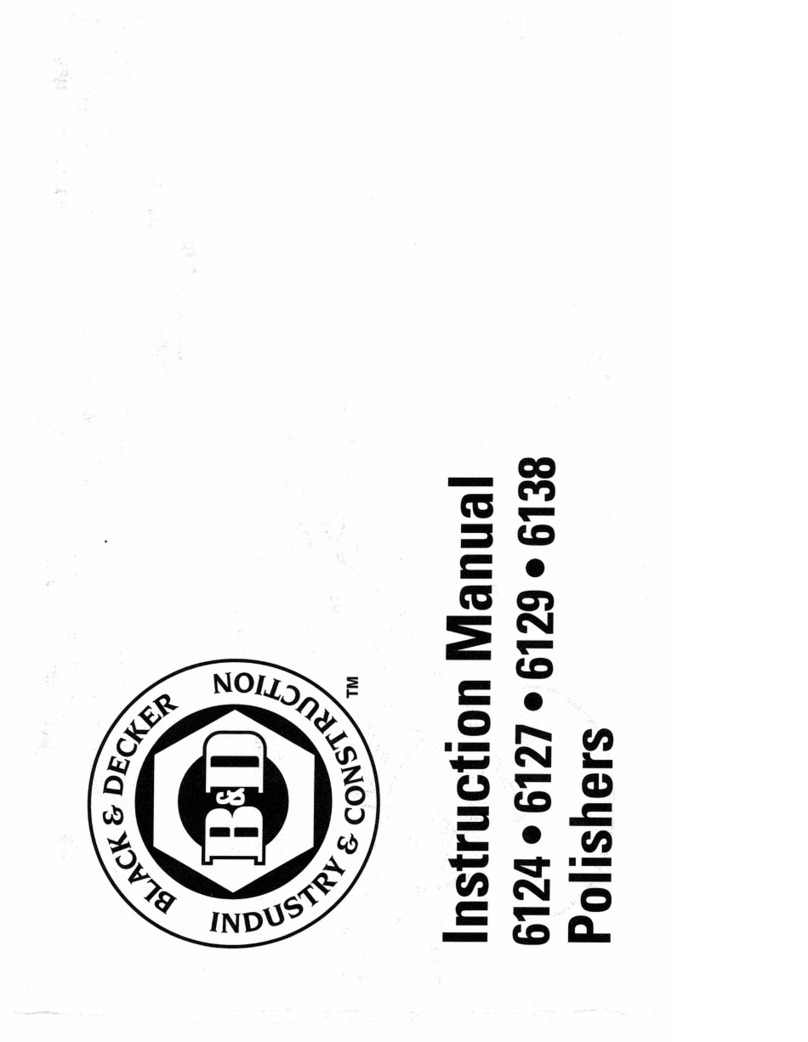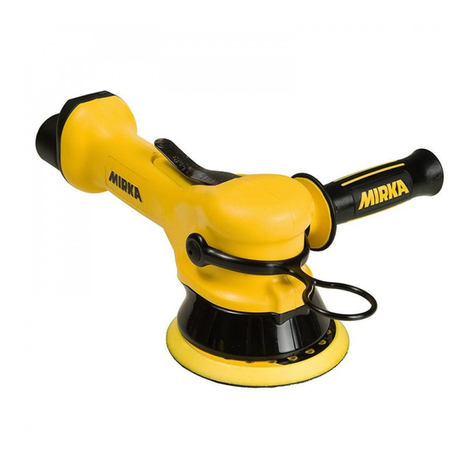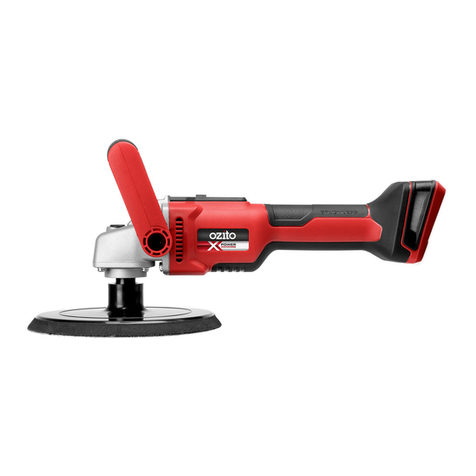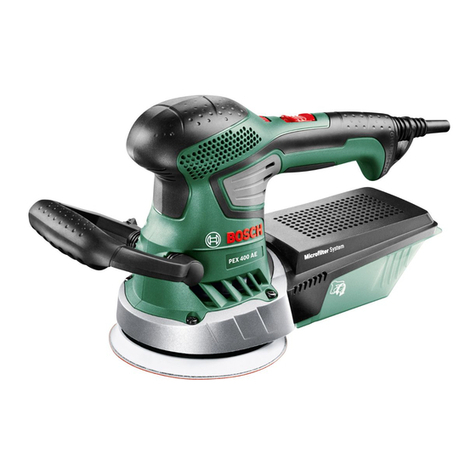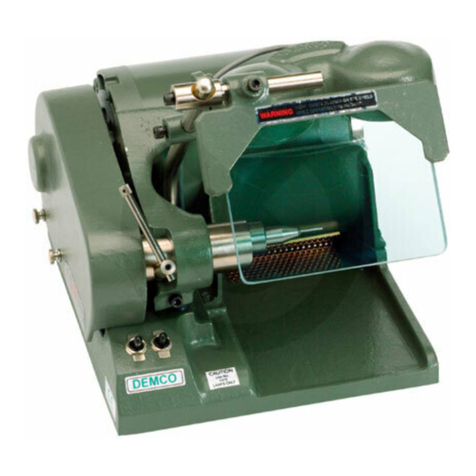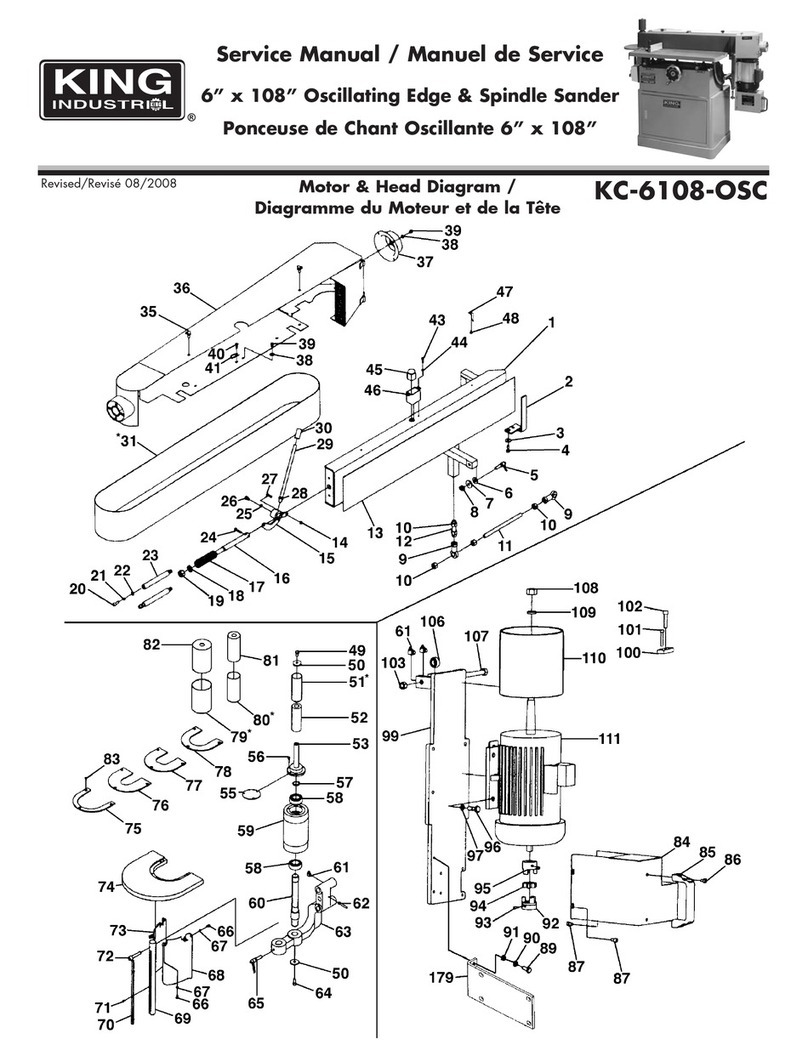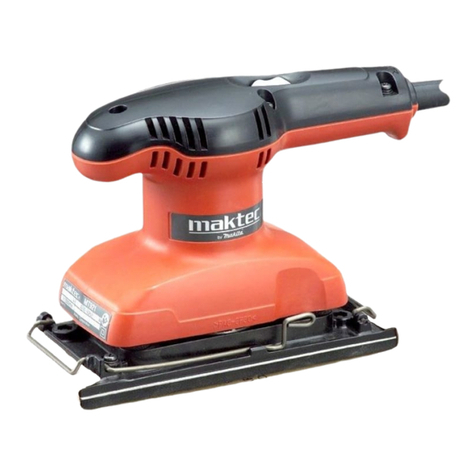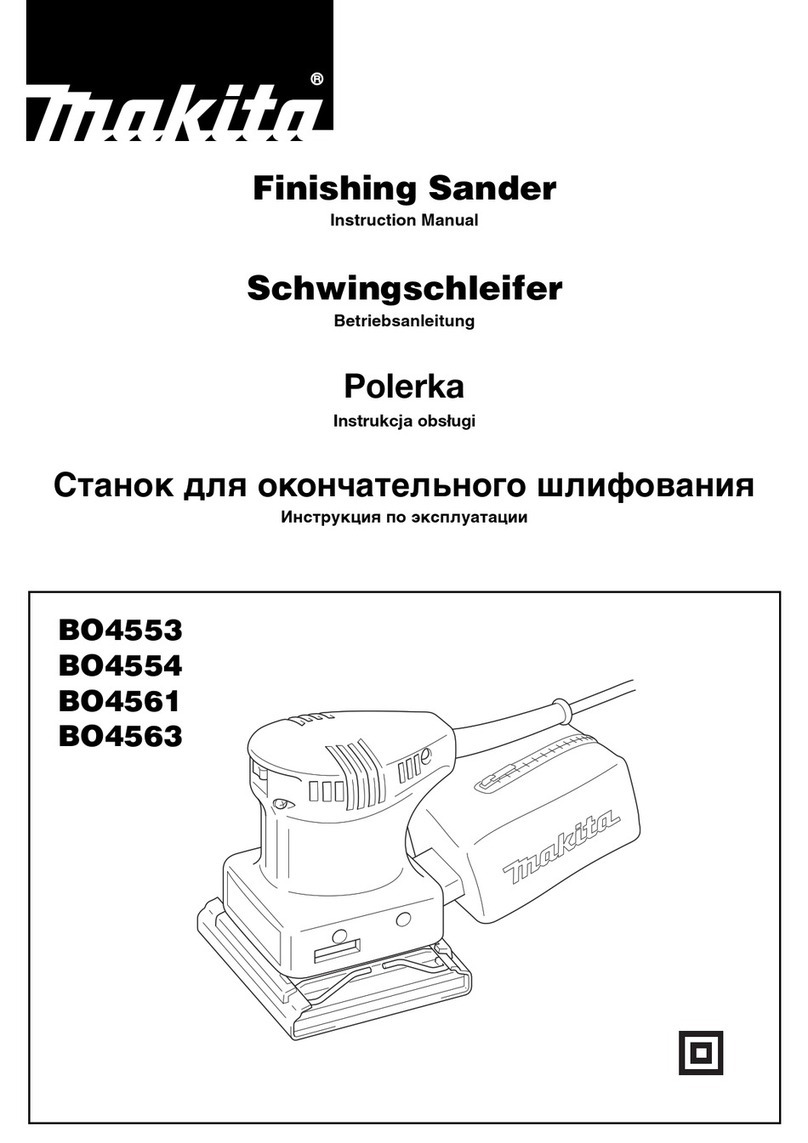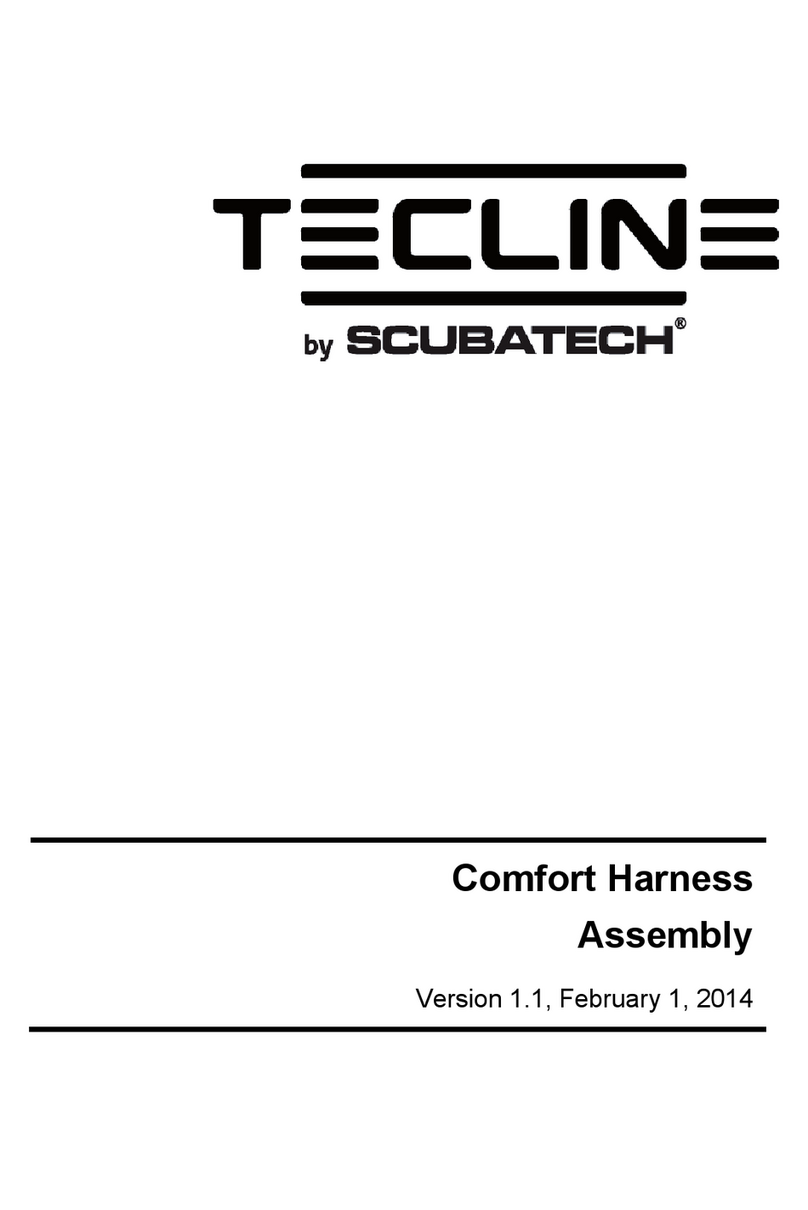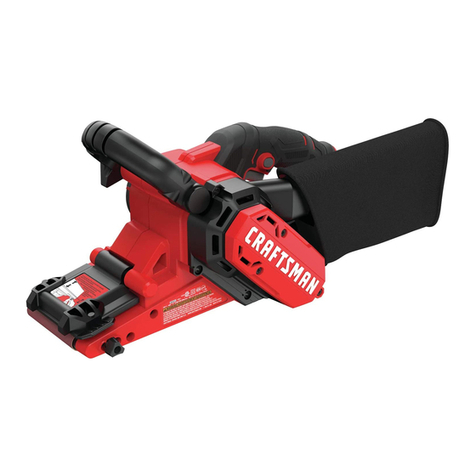BAS technic 9259 User manual

BGS technic KG
Bandwirkerstr. 3
42929 Wermelskirchen
Tel.: 02196 720480
Fax.: 02196 7204820
mail@bgs-technic.de
www.bgstechnic.com
© BGS technic KG, Vervielfältigung und Weiterverwendung verboten
Art. 9259
Akku-Poliermaschine
WICHTIG: Bitte lesen Sie die Bedienungsanleitung sorgfältig.
Beachten Sie alle Warnungen und Sicherheitshinweise.
Verwenden Sie dieses Produkt immer korrekt und mit Sorgfalt für den Zweck, für den es bestimmt ist.
Nichtbeachtung kann zu Schäden oder Verletzungen und zum Erlöschen der Garantie führen.
1. EINFÜHRUNG
Diese leistungsstarke, kompakte Poliermaschine wurde konzipiert zum Polieren von kleinen Flächen.
Dieses gut ausgewogene Werkzeug verfügt über eine Drehzahleinstellung und wird inkl. Akku und
Ladegerät ausgeliefert.
2. SPEZIFIKATION
Freilauf-Drehzahl: 0 - 3000 U/min (stufenlos einstellbar)
Polierteller: 100 mm
Maschinengewicht: ca. 820 g
Schalldruckpegel LpA:71 dB(A) / KpA: 3 dB(A)
Schallleistungspegel LwA:82dB(A) / KwA: 3 dB(A)
Vibrationspegel ah: 2,68 m/s²
Vibrationspegel K: 1,5 m/s²
Akku: 10,8 Li-ion / 1,3 Ah
Ladegerät: Eingang: 100 - 240 VAC /50 – 60 Hz/ 30 W Ausgang: 12,6 VDC, 1500 mA
Abtriebswellen-Gewinde: M10

BGS technic KG
Bandwirkerstr. 3
42929 Wermelskirchen
Tel.: 02196 720480
Fax.: 02196 7204820
mail@bgs-technic.de
www.bgstechnic.com
© BGS technic KG, Vervielfältigung und Weiterverwendung verboten
3. SICHERHEITSHINWEISE
3.1. Allgemeine Sicherheitshinweise
-Befolgen Sie alle Sicherheitsregeln, Vorschriften und Bedingungen bei der Verwendung des
Akkuwerkzeugs.
-Entfernen Sie den Akku aus dem Werkzeug vor der Durchführung von Wartungsarbeiten
-Halten Sie Werkzeug und Akku immer in einem guten Zustand. Überprüfen Sie ob alle
beweglichen Teile freigängig sind.
-Lassen Sie beschädigte Bauteile immer von einer fachkundigen Person austauschen und
verwenden Sie immer Originalteile.
-Achten Sie beim Einsetzen des Akkus darauf, dass das Akkuwerkzeug auf AUS steht.
-Halten Sie Werkzeug, Akku und Ladegerät stehts sauber.
-Halten Sie Ihren Arbeitsbereich sauber und frei von nicht verwendeten Materialien. Sorgen Sie
für eine ausreichende Beleuchtung.
-Stellen Sie vor Verwendung sicher, dass der Akku feste im Akkuschacht sitz.
-Vermeiden Sie unbeabsichtigtes Einschalten des Akkuwerkzeugs.
-Tragen Sie bei Verwendung des Akkuwerkzeugs immer eine zugelassene Schutzbrille mit
geschlossenen Seiten, Gehörschutz und Handschuhe.
-Vermeiden Sie das Tragen weiter Kleidung oder Schmuck und binden Sie lange Haare
zusammen.
-Stellen Sie sicher, dass der Boden nicht rutschig ist und tragen Sie rutschfeste Schuhe.
-Halten Sie Kinder und unbefugte Personen aus dem Arbeitsbereich fern.
-Betreiben Sie den Akkuwerkzeug nicht, wenn Teile fehlen oder defekt sind. Dies kann zu
Versagen und Verletzungen führen.
-Verwenden Sie Akkuwerkzeug nicht, bevor Sie von einer qualifizierten Person unterwiesen sind
bzw. die Bedienungsanleitung gelesen haben.
-Betreiben Sie das Akkuwerkzeugs nicht in Räumen, in denen sich brennbare Gase, Flüssigkeiten
oder Feststoffe befinden.
-Lassen Sie den Akkuwerkzeug niemals unbeaufsichtigt.
-Betreiben das Akkuwerkzeug nicht, wenn Sie müde sind oder unter Einfluss von Alkohol, Drogen
oder Medikamenten stehen.
-Verwendung Sie Akkuwerkzeug und Ladegerät nicht in feuchter Umgebung.
-Lagern Sie Akkuwerkzeug und Ladegerät an einem sicheren, trockenen und für Kinder nicht
erreichbaren Ort bei einer Temperatur nicht über 40°C (104°F).
3.2 AKKU SICHERHEITSHINWEISE
-WARNUNG! Der Akku enthält gefährliche Stoffe und muss daher mit Vorsicht behandelt werden
-Laden Sie den Akku vor dem ersten Gebrauch. Der Akku wird in einem niedrigen Ladezustand
ausgeliefert.
-Verwenden Sie nur das mitgelieferte Ladegerät zum Aufladen des Akkus.
-Laden Sie den Akku nicht bei Raumtemperatur unter 10°C (50°F) oder über 40°C (104°F).
-Versuchen Sie nicht den Akku mit z.B. einem Generator oder einer anderen Gleichstromquelle zu
laden.
-Schließen Sie den Akku nicht kurz. Berühren Sie nicht beide Anschlüsse zur gleichen Zeit mit
einem Metallgegenstand.
-ACHTUNG! Entsorgen Sie Sie den verbrauchten Akku richtig! Dieser Akku enthält gefährliche
Stoffe.
-GEFAHR! Versuchen Sie nicht den Akku zu zerlegen. Aus Sicherheits- und
Umweltschutzgründen darf der Akku nicht mit normalem Hausmüll entsorgt werden.
-Entsorgen Sie Akku oder Schlagschrauber immer gemäß den behördlichen Vorschriften.
-ACHTUNG! Eventuell Auslaufende Akkus niemals mit der bloßen Hand berühren oder in Kontakt
mit Haut bringen.
-Sollte ein solcher Fall eintreten und Haut, Augen, etc. ist mit der auslaufenden Flüssigkeit in
Kontakt gekommen, suchen Sie sofort einen Arzt auf.
-Vergewissern Sie sich, dass der Drehzahlregler in Stellung 0 steht, bevor Sie den Akku mit der
Poliermaschine verbinden.

BGS technic KG
Bandwirkerstr. 3
42929 Wermelskirchen
Tel.: 02196 720480
Fax.: 02196 7204820
mail@bgs-technic.de
www.bgstechnic.com
© BGS technic KG, Vervielfältigung und Weiterverwendung verboten
3.3. ELEKTRO SICHERHEITSHINWEISE (In Bezug auf das Akku-Ladegerät)
-WARNUNG! Es liegt in der Verantwortung des Eigentümers / Betreibers folgende
Sicherheitshinweise zu lesen, zu verstehen und zu befolgen:
-Sicherzustellen, dass die Isolierung der Kabel im einwandfreien Zustand sind, bevor das
Ladegerät mit der Stromversorgung verbunden wird.
-Tragen Sie das Ladegerät nicht am Stromkabel.
-Verwenden Sie keine abgenutzten oder beschädigten Kabel, Stecker oder Anschlüsse. Liegt ein
Fehler in der Verkabelung vor darf das Ladegerät erst nach erfolgter Reparatur durch eine
sachkundige Person weiter verwendet werden.
3.4. SICHERHEITSHINWEISE BATTERIE-LADEGERÄT
-ACHTUNG! Verwenden Sie niemals einen typfremden Akku. Verwendung anderer Akkus kann
zur Explosion dieser führen.
-Trennen Sie das Ladegerät bei Nichtverwendung von der Netzspannung.
-Laden Sie den Akku nicht bei Raumtemperaturen unter 10°C (50°F) oder über 40°C (104°F).
-Setzen Sie das Ladegerät keiner Feuchtigkeit aus.
-Tragen Sie das Ladegerät nicht am Spannungsversorgungskabel.
-Verwenden Sie das Ladegerät nicht wenn es heruntergefallen oder wenn ein Defekt offensichtlich
ist. Lassen Sie das Gerät durch eine sachkundige Person reparieren.
-Zerlegen Sie das Gerät nicht, dies kann zur Zerstörung des Gerätes, zu Verletzungen oder zum
Erlöschen der Garantie führen.
-Stecken Sie keine Objekte in die Gehäuseöffnungen.
-Lassen Sie das Ladegerät zwischen 2 Ladevorgängen ca. 15 Minuten abkühlen, insbesondere
wenn der erste Ladevorgang beendet ist und ein zweiter Akku direkt im Anschluss geladen
werden soll. Das nacheinander laden von Akkus kann zur Überhitzung des Ladegerätes führen.
-Lagern Sie Ladegerät an einem sicheren, trockenen und für Kinder nicht erreichbaren Ort bei
einer Temperatur nicht über 40°C (104°F).
4. BEDIENUNGSANLEITUNG
4.1. TEILE-BESCHREIBUNG
1Wellenarretierung
2 Drehzahlregler
3 Akku 10,8 V
4 Klettscheibe
5 Akku-Zustandsanzeige
6 Akku-Entriegelung
7 Abtriebswelle M10
8 Ein- / Ausschalttaste
LADEGERÄT
Keine LED leuchtet
Ladegerät ist nicht mit
Netzspannung
verbunden
Grüne LED leuchtet
Ladegerät ist mit
Netzspannung
verbunden
Rote LED leuchtet
Akku wird geladen
Grüne LED leuchtet
Akku fertig geladen
4
Abb. 2
Abb. 3
Abb. 4
Abb. 5
Abb. 1

BGS technic KG
Bandwirkerstr. 3
42929 Wermelskirchen
Tel.: 02196 720480
Fax.: 02196 7204820
mail@bgs-technic.de
www.bgstechnic.com
© BGS technic KG, Vervielfältigung und Weiterverwendung verboten
4.2. LADEN DER BATTERIE
4.2.1. Entfernen Sie den Akku durch Drücken der zwei Entriegelungsclipse (Abb.1.6). WARNUNG!
Berühren Sie nicht die Metallklemmen.
4.2.2. Legen Sie das Akkuwerkzeug zur Seite und nehmen Sie das Ladegerät.
4.2.3. Die Anschlüsse am Akku und am Ladegerät sind mit positiv (+) und negativ (-) markiert.
Richten Sie die Markierungen korrekt zueinander aus und schieben Sie den Akku in das
Ladegerät (Abb.4 & 5). Hinweis: Der Akku ist so konzipiert, dass dieser nur korrekt
ausgerichtet in das Ladegerät passt. Drücken Sie den Akku unter leichtem Druck nach unten
in die Ladeanschlüsse.
4.2.4. Verbinden sie das Ladegerät mit der Netzversorgung; rote LED leuchtet (Abb.4). Der
Ladevorgang beginnt.
4.2.5. Wenn der Ladevorgang abgeschlossen ist, erlischt die rote LED und die grüne LED leuchtet
(Abb.5) Der Akku ist jetzt einsatzbereit. Hinweis: Der Akku hat bei Auslieferung einen
niedrigen Ladezustand. Die ersten Aufladungen zur optimalen Akkuleistung wird etwas mehr
Zeit in Anspruch nehmen. Normale Ladezeit beträgt ca. 1 Stunde.
4.2.6. Trennen Sie, nach dem Entfernen der Batterie, das Ladegerät von der Netzspannung und
lagern Sie es zur sicheren Aufbewahrung an einem trockenen Ort.
4.2.7. Vergewissern Sie sich, dass der Drehzahlregler in Stellung 0 steht, bevor Sie den Akku mit
der Poliermaschine verbinden.
4.3. POLIERMASCHINE VERWENDEN
4.3.1. Achtung: Klettscheibe (Abb.1.4) vor der ersten Verwendung befestigen. Dazu die
Wellenarretierung (Abb.1.1) drücken und die Klettscheibe leicht drehen bis die Arretierung
fühlbar einrastet. Jetzt kann die Klettscheibe durch drehen im Uhrzeigersinn befestigt
werden. Es ist ausreichend die Klettscheibe von Hand leicht anzuziehen. Wellenarretierung
loslassen und prüfen ob die Klettscheibe sich frei drehen lässt.
4.3.2 . Richten Sie die Zunge an der Batterie mit der Nut im Werkzeuggehäuse aus und setzen
Sie den Akku ein. Stellen Sie sicher, dass der Akku verriegelt im Gehäuse sitzt
(durch Klick-Geräusch hörbar)
4.3.3. Wählen Sie den benötigten Aufsatz und setzen Sie diesen mittig auf den Klettscheibe.
4.3.4. Stellen Sie mit dem Drehzahlregler (Abb.1.2) die gewünschte Drehzahl ein.
4.3.5. Zur Demontage der Klettscheibe (Abb.1.4) die Wellenarretierung (Abb.1.1) drücken und
die Klettscheibe gegen den Uhrzeigersinn drehen
5. PFLEGE
5.1. REINIGUNG
Halten Sie das Akkuwerkzeug sauber und fettfrei.
Reinigen Sie den Akkuwerkzeug nur mit einem feuchten Tuch.
Verwenden Sie niemals Lösungsmittel zur Reinigung.
Für alle anderen Service-, Reparatur- und Wartungsarbeiten wenden Sie sich bitte an eine
sachkundige Person.
6. UMWELTSCHUTZ
Recyceln Sie unerwünschte Stoffe, anstatt sie als Abfall zu entsorgen. Alle Werkzeuge,
Zubehörteile und Verpackungen sind zu sortieren, einer Wertstoffsammelstelle zuzuführen und
umweltgerecht zu entsorgen.
7. ENTSORGUNG
Entsorgen Sie Akkus und Batterien nicht im Hausmüll. Akkus und Batterien sollten auf
verantwortungsvolle Weise entsorgt werden. Geben Sie Akkus und Batterien an einer geeigneten
Sammelstelle ab. Entsorgen Sie dieses Produkt am Ende seiner Lebensdauer gemäß der EU-
Richtlinie über Elektro- und Elektronikaltgeräte. Erkundigen Sie sich bei Ihrer örtlichen
Abfallbehörde über Recyclingmaßnahmen oder geben Sie das Produkt zur Entsorgung an die
BGS technic KG oder einen Elektrofachhändler.

BGS technic KG
Bandwirkerstr. 3
D-42929 Wermelskirchen
Tel.: 02196 720480
Fax.: 02196 7204820
mail@bgs-technic.de
www.bgstechnic.com
© BGS technic KG, Copying and further use not allowed
BGS 9259
Cordless Polishing Machine
IMPORTANT: Please read these instructions carefully.
Note the safe operational requirements, warnings, and cautions.
Use this product correctly, and with care for the purpose for which it is intended.
Failure to do so may cause damage and / or personal injury and will invalidate the warranty.
1. INTRODUCTION
This powerful and compact cordless polishing machine is made for polishing of small surfaces. This
well-balanced tool has a speed setting and comes with battery and charger.
2. SPECIFICATION
Free speed: 0- 3000 rpm (stepless adjustable)
Pad diameter:100 mm
Machine weight: approx. 820 g
Sound pressure level LpA: 71 dB(A) / KpA:3 dB
Sound pressure level LwA: 82 dB(A) / KwA: 3 dB
Vibration level ah: 2.68 m/s²
Vibration level K: 1.5 m/s²
Battery pack: 10.8 VLi-ion / 1.3Ah
Battery Charger: Input: 100 - 240 VAC /50 – 60 Hz/ 30 W Output: 12.6 VDC 1500 mA
Outputshaft thread: M10

BGS technic KG
Bandwirkerstr. 3
D-42929 Wermelskirchen
Tel.: 02196 720480
Fax.: 02196 7204820
mail@bgs-technic.de
www.bgstechnic.com
© BGS technic KG, Copying and further use not allowed
3. SAFETY INSTRUCTIONS
3.1. GENERAL SAFETY
-Follow all workshop safety rules, regulations and conditions when using the cordless tool.
-Remove the battery pack from the cordless tool before servicing or performing any maintenance.
-Maintain the cordless tool and battery pack in good condition. Check moving parts for alignment
on a regular basis.
-Replace or repair damaged parts. Use an authorised service agent and recommended parts only.
Unauthorised parts may be dangerous and will invalidate the warranty.
-Ensure the cordless tool is ‘off’ before installing the battery pack.
-Keep the cordless tool, battery pack and charger clean for optimum performance.
-Keep the work area clean and tidy and free from unrelated materials. Ensure that there is
adequate lighting.
-Ensure that battery pack is correctly inserted into the cordless tool and latched in place before
operating cordless tool.
-Avoid unintentional starting.
-Wear approved safety eye/face shield, ear defenders and hand protection.
-Remove ill-fitting clothing. Remove ties, watches, rings and other loose jewellery and contain long
hair.
-Maintain correct balance and footing. Ensure the floor is not slippery and wear non-slip shoes.
-Keep children and unauthorised persons away from the work area.
-DO NOT operate the cordless tool if any parts are missing as this may cause failure and personal
injury.
-DO NOT use the cordless tool unless you have been instructed in its use by a qualified person.
-DO NOT operate the cordless tool where there are solvent fumes or flammable gases, liquids or
solids.
-DO NOT use the cordless tool for a task it is not designed to perform.
-DO NOT operate the cordless tool when you are tired or under the influence of alcohol, drugs or
intoxicating medication.
-DO NOT get the cordless tool or battery charger wet or use in damp or wet locations.
-Keep cordless tool and charger in a safe, dry, childproof area where the temperature will not
exceed 40°C (104°F).
3.2 BATTERY SAFETY INSTRUCTIONS
WARNING! The battery pack contains nickel-cadmium, which is dangerous. It must therefore be
handled with care.
-Charge the battery pack prior to first use. The battery pack will have been shipped in a low charge
state.
-Use only the charger provided to charge the battery pack.
-DO NOT charge the battery pack when room temperature is below 10°C (50°F) or above 40°C
(104°F).
-DO NOT attempt recharging the pack by means of an engine generator or a DC power source.
-DO NOT short-circuit the battery pack by touching both terminals at the same time with a metal
object, or your fingers etc.
-DO NOT store battery pack (or cordless tool) in locations where the temperature may exceed
40°C (104°F) e.g. in outside sheds, above heaters etc.
-WARNING! Dispose of spent battery pack correctly as it contains nickel-cadmium.
-DANGER! DO NOT attempt to disassemble the battery pack. For safety and environmental
reasons DO NOT discard in domestic waste or by burning. ONLY discard or recycle according to
local authority regulations.
WARNING! DO NOT allow a leaking battery to contact your person. If you come into contact with
battery liquid seek immediate medical attention.
-Make sure that the speed controller is in position 0before connect the battery.

BGS technic KG
Bandwirkerstr. 3
D-42929 Wermelskirchen
Tel.: 02196 720480
Fax.: 02196 7204820
mail@bgs-technic.de
www.bgstechnic.com
© BGS technic KG, Copying and further use not allowed
3.3. MAINS POWER ELECTRICAL SAFETY (In relation to the battery charger)
WARNING! It is the responsibility of the owner and the operator to read, understand and comply with
the following:
-Ensure that the insulation on cables is safe before connecting it to the power supply.
-Do not pull or carry the appliance by the power cable.
-Do not use worn or damage cables, plugs or connectors. Immediately have any faulty item
repaired or replaced by a qualified electrician.
3.4. BATTERY CHARGER SAFETY INSTRUCTIONS
-WARNING! Do not attempt to charge any battery other than that supplied for the cordless tool.
Other types of batteries may explode!
-Disconnect the charger from the mains supply when not in use.
-Do not charge battery if room temperature is below 10°C (50°F) or above 40°C (104°F).
-Do not expose the charger to damp or wet conditions.
-Do not pull or carry the charger by the power lead.
-Do not operate the charger if it has been dropped, or has received a sharp knock, or is damaged.
Take the charger to an authorised agent for repair or obtain a replacement.
-Do not dismantle the charger as this may cause damage and personal injury and will invalidate
the warranty.
-Do not insert foreign objects or material into the hole reserved for the battery pack.
-Do not recharge a second battery pack immediately after charging the first. Consecutive charging
will overheat the charger. Allow the unit to cool for 15 minutes before charging the next pack.
-Do not attempt to connect two chargers together.
-Store the charger in a same manner as the battery pack.
4. OPERATING INSTRUCTIONS
4.1. PARTS DESCRIPTION
1Shaft lock
2 Speed controll
3 Battery 10.8V
4 Velcro adapter
5 Battery indicator
6 Battery retaining clip
7 Output shaft M10
8 On / Off button
CHARGER
No LED lights
Charger not connected
to main voltage
Green LED lights
Charger is connected
to main voltage
Red LED lights
Battery is charging
Green LED lights
Battery has charged
fig. 3
fig. 2
fig. 4
fig. 5
fig. 1

BGS technic KG
Bandwirkerstr. 3
D-42929 Wermelskirchen
Tel.: 02196 720480
Fax.: 02196 7204820
mail@bgs-technic.de
www.bgstechnic.com
© BGS technic KG, Copying and further use not allowed
4.2. CHARGING THE BATTERY PACK
4.2.1. Remove the battery pack from the wrench, by depressing the two side retaining clips (fig.1.6).
WARNING! Do not touch metal terminals.
4.2.2. Place the cordless tool to side and take the battery charger.
4.2.3. The battery pack and charger have the positive (+) and negative (-) terminals marked. Align
the correct terminals and insert the battery into slot (fig. 4 & 5).
Note: The battery pack is designed so that it will only enter the charger unit the correct way.
When placed in the charger, a very slight downward pressure will seat the pack firmly into the
power terminals.
4.2.4. Connect the charger to mains supply; red LED lights (fig. 4).
Charging begins.
4.2.5. When charging is complete, the red LED goes out and the green LED lights (fig. 5). The
battery is now ready to use. Note: When new, the battery pack will have been shipped in a low
charge state. It will take longer to charge initially, and several subsequent charges may also
take a little longer than when the battery pack reaches its optimum performance. Normal
charging time is approximately 1 hour.
4.2.6. After removing the battery, disconnect the charger from the mains supply and store it for
safekeeping in a dry place.
4.2.7. Make sure that the speed controller is in position 0before connect the battery to polishing
machine.
4.3. USING POLISHING MACHINE
4.3.1. Warning: Fix the Velcro adapter (fig. 1.4) before first use. Press the shaft lock (fig. 1.1) and
rotate the velcro adapter until the lock is latched. Now the velcro adapter can be fixed by
turning clockwise. It is enough to tighten the Velcro adapter by hand. Release the shaft lock
and check whether the Velcro adapter can rotate freely.
4.3.2. Fit the battery pack to the cordless tool by aligning the tongue on the battery with the groove in
the housing and slide it into place. Ensure that the battery pack is firmly located, you will hear
an audible click when it has locked into position.
4.3.3. Select the required pad and insert it centered on the Velcro adapter.
4.3.4. Set the desired speed by turning the speed controller (fig. 1.2).
4.3.5. To remove the velcro adapter (fig. 1.4), press the shaft lock (fig. 1.1) and turn it counter
clockwise.
5. MAINTENANCE
Keep the outer case of the cordless tool clean and free from grease.
Do not wash with water or use solvents or abrasives. Use a damp cloth.
For any other service or maintenance, contact your authorised service agent.
6. ENVIRONMENTAL PROTECTION
Recycle unwanted materials instead of disposing of them as waste. All tools, accessories and
packaging should be sorted, taken to a recycling centre and disposed of in a manner which is
compatible with the environment.
7. DISPOSAL
Do not dispose battery in household waste. Batteries should be disposed of in a responsible
manner, they must be disposed at appropriate collection point.
Dispose of this product at the end of its working life in compliance with the EU Directive on Waste
Electrical and Electronic Equipment. Contact your local solid waste authority for recycling
information or give the product for disposal to BGS technic KG or to an electrical appliances
retailer.

BGS technic KG
Bandwirkerstr. 3
D-42929 Wermelskirchen
Tel.: 02196 720480
Fax.: 02196 7204820
mail@bgs-technic.de
www.bgstechnic.com
BGS 9259
Polisseuse sur accu
IMPORTANT : Veuillez lire attentivement ce mode d’emploi.
Veuillez prendre en compte tous les avertissements et instructions.
Utilisez toujours correctement et soigneusement ce produit, uniquement pour le but pour lequel il a
été conçu.
Ignorer les instructions peut entraîner des endommagements, des blessures et la perte de la
couverture de garantie.
1. INTRODUCTION
Cette polisseuse, puissante et compacte, a été conçue pour le polissage de surfaces réduites. Cet
outil bien équilibré dispose d’un réglage de vitesse et estfourni avec un accu et un chargeur.
2. SPÉCIFICATION
Vitesse à vide :environ 0– 3000 tr/min (réglable en continu)
Disque de polissage :100 mm
Poids approx. :820 g
Niveau de pression acoustique LpA :71 dB (A)/KpA : 3 dB (A)
Niveau de puissance acoustique LwA:82 dB (A)/KwA : 3 dB (A)
Niveau vibratoire (ah) : 2,68 m/s²
Pic de vibration (k) : 1,5 m/s²
Batterie :10,8Li-ion/1,3 Ah
Chargeur : Entrée :100 - 240 VAC /50 – 60 Hz / 30 W Sortie: 12.6 VDC 1500 mA
Filetage de l’arbre de sortie :M10

BGS technic KG
Bandwirkerstr. 3
D-42929 Wermelskirchen
Tel.: 02196 720480
Fax.: 02196 7204820
mail@bgs-technic.de
www.bgstechnic.com
3.CONSIGNES DE SÉCURITÉ
3.1. Consignes générales de sécurité
-Respectez toutes les règles, réglementations et conditions de sécurité lors de l’utilisation de l’outil sans
fil.
-Retirez l’accu de l’outil avant d’entreprendre des travaux d’entretien.
-Gardez toujours en bon état l’outil et l’accu. Vérifiez que toutes les pièces mobiles peuvent bouger
librement.
-Faites toujours remplacer les composants endommagés par une personne compétente et utilisez
toujours des pièces d’origine.
-Lors de l’insertion de l’accu, assurez-vous que le commutateur marche/arrêt de l’outil sans fil est en
position OFF.
-Gardez toujours propres l’outil, l’accu et le chargeur.
-Maintenez toujours propre et sèche votre zone de travail et éliminez les matériaux inutilisés. Assurez
un éclairage adéquat.
- Assurez-vous que l’accu est bien en place dans son compartiment avant d’utiliser l’outil sans fil.
-Évitez d’allumer par inadvertance l’outil sans fil.
-Portez toujours des lunettes de protection approuvées avec des côtés fermés, des protections
auditives et des gants lorsque vous utilisez l’outil sans fil.
-Évitez de porter des vêtements amples ou des bijoux et si vous avez les cheveux longs, attachez-les.
-Veillez à ce que le sol ne soit pas glissant et portez des chaussures antidérapantes.
-Maintenez à l’écart les enfants et toutes les personnes non autorisées de la zone de travail.
-N’utilisez pas l’outil lorsque des pièces manquent ou sont endommagées. Cela peut entraîner de
graves blessures.
-N’utilisez pas l’outil sans fil avant d’avoir été instruit par une personne qualifiée ou d’avoir lu le mode
d’emploi.
-N’utilisez jamais l’outil sans fil dans des pièces contenant des gaz, des vapeurs ou des poussières
inflammables.
-Ne laissez jamais l’outil sans fil sans surveillance.
-N’utilisez pas l’outil sans fil quand vous êtes fatigué(e) ou sous l’influence d’alcool, de drogues ou de
médicaments.
-N’utilisez pas l’outil sans fil ou son chargeur dans un environnement humide.
-Conservez l’outil sans fil et son chargeur dans un endroit sûr et sec, hors de portée des enfants et à
une température ne dépassant pas 40°C (104°F).
3.2 INSTRUCTIONS DE SÉCURITÉ POUR ACCUS
-AVERTISSEMENT ! L’accu contient des substances dangereuses et doit donc être manipulé avec
précaution
-Chargez l’accu avant la première utilisation de l’outil. L’accu est livré avec une charge très légère.
-N’utilisez que le chargeur fourni pour charger l’accu.
-Ne chargez pas l’accu à une température ambiante inférieure à 10°C (50°F) ou supérieure à 40°C
(104°F).
-N’essayez pas de charger l’accu avec, par exemple, un générateur ou une autre source de courant
continu.
-Évitez de décharger complètement l’accu. Ne touchez pas les deux bornes en même temps avec un
objet métallique.
-ATTENTION ! Veuillez éliminer l’accu de manière écologique à la fin de sa vie utile ! Cet accu contient
des substances dangereuses.
-DANGER ! N’essayez jamais de démonter l’accu. Pour des raisons de sécurité et par respect de
l’environnement, l’accu ne doit pas être jeté avec les déchets ménagers normaux.
-Éliminez l’accu et/ou la clé à choc strictement selon les consignes des autorités locales.
-ATTENTION ! Ne touchez jamais à main nue des accus qui fuient et ne les mettez jamais en contact
avec la peau.
-Si un tel cas se produit et que la peau, les yeux, etc. ont été en contact avec le liquide qui fuit de
l’accu, consultez immédiatement un médecin.
- Assurez-vous que le régulateur de vitesse est en position 0 avant de connecter l’accu sur la
polisseuse.

BGS technic KG
Bandwirkerstr. 3
D-42929 Wermelskirchen
Tel.: 02196 720480
Fax.: 02196 7204820
mail@bgs-technic.de
www.bgstechnic.com
3.3. INSTRUCTIONS DE SÉCURITÉ ÉLECTRIQUE (concernant le chargeur de l’accu)
-AVERTISSEMENT ! Il incombe au propriétaire/opérateur de lire, comprendre et suivre les instructions
de sécurité suivantes :
- Assurez-vous que l’isolation des câbles est en bon état avant de connecter le chargeur à l’alimentation
électrique.
-Ne portez jamais le chargeur en le tenant par le cordon d’alimentation.
-N’utilisez pas de câbles, de fiches ou de connecteurs usés ou endommagés. S’il y a un défaut dans le
câblage, le chargeur ne peut être utilisé qu’après avoir été réparé par une personne compétente.
3.4. CONSIGNES DE SÉCURITÉ RELATIVES AU CHARGEUR
-ATTENTION ! N’utilisez jamais un accu d’un autre type. L’utilisation d’autres accus peut entraîner une
explosion.
-Séparez le chargeur du secteur lorsque vous ne l’utilisez pas.
-Ne chargez pas l’accu à une température ambiante inférieure à 10°C (50°F) ou supérieure à 40°C
(104°F).
-N’exposez pas le chargeur à l’humidité.
-Ne portez jamais le chargeur en le tenant par le cordon d’alimentation.
-N’utilisez pas le chargeur s’il est tombé ou si un défaut est évident. Ne faites réparer l’appareil que par
des personnes compétentes.
-Ne démontez pas l’appareil, cela peut entraîner la destruction de l’appareil, des blessures et
l’annulation de la couverture de garantie.
-N’insérez pas d’objets dans les ouvertures du boîtier.
-Laissez se refroidir le chargeur pendant environ 15 minutes entre 2 processus de charge, surtout
lorsque le premier processus de charge est terminé et qu’un deuxième accu doit être chargé
immédiatement après. Le fait de charger plusieurs accus les uns après les autres peut provoquer une
surchauffe du chargeur.
-Conservez le chargeur dans un endroit sûr et sec, hors de portée des enfants et à une température ne
dépassant pas 40°C (104°F).
4. MANUEL D’UTILISATION
4.1. DESCRIPTION DES COMPOSANTS
1Blocage de l’arbre
2 Contrôleur de vitesse
3 Accu de 10,8 V
4 Disque Velcro
5 Affichage de l’état de l’accu
6 Déverrouillage de l’accu
7 Arbre de sortie M10
8 Bouton Marche/Arrêt
CHARGEUR
Aucune LED ne
s’allume
Le chargeur n’est pas
branché sur le secteur
La LED verte s’allume
Le chargeur est
branché sur le secteur
La LED rouge
s’allume
L’accu est en cours de
chargement
La LED verte s’allume
L’accu est chargé
4
Fig. 2
Fig. 3
Fig. 4
Fig. 5
Fig. 1

BGS technic KG
Bandwirkerstr. 3
D-42929 Wermelskirchen
Tel.: 02196 720480
Fax.: 02196 7204820
mail@bgs-technic.de
www.bgstechnic.com
4.2. CHARGEMENT DE L’ACCU
4.2.1. Retirez l’accu en appuyant sur les deux clips de libération (Fig.1.6). AVERTISSEMENT ! Ne
touchez pas les pinces métalliques.
4.2.2. Mettez l’outil sans fil de côté et prenez le chargeur.
4.2.3. Les raccords de l’accu et du chargeur sont marqués par un symbole positif (+) et un symbole
négatif (-). Raccordez correctement les bornes et glissez l’accu dans le chargeur (Fig.4 & 5).
Remarque : L’accu est conçu de manière à ne pouvoir s’insérer dans le chargeur que lorsqu’il
est correctement aligné. Poussez l’accu vers le bas avec une légère pression pour
l’enclencher sur les raccords de charge.
4.2.4. Branchez le chargeur sur le secteur ; la LED rouge s’allume (Fig. 4). Le processus de
chargement commence.
4.2.5. Lorsque le processus de chargement est terminé, la LED rouge s’éteint et la LED verte
s’allume (Fig.5). L’accu est maintenant prêt à l’emploi. Remarque : À la livraison, l’accu n’est
que faiblement chargé. Afin obtenir une performance optimale, les premières recharges de
l’accu prendront un peu plus de temps. Le temps de charge normal est d’environ 1 heure.
4.2.6. Après avoir retiré l’accu, débranchez le chargeur du secteur et rangez-le dans un endroit sec
pour le conserver.
4.2.7. Assurez-vous que le régulateur de vitesse est en position 0 avant de connecter l’accu sur la
polisseuse.
4.3. UTILISATION DE LA POLISSEUSE
4.3.1. Attention : Fixez le disque Velcro (Fig. 1.4) avant la première utilisation. Pour ce faire,
appuyez sur le blocage de l’arbre (Fig. 1.1) et tournez légèrement le disque Velcro jusqu’à ce que le
verrou s’enclenche fermement. Le disque Velcro peut maintenant être fixé en le tournant dans le sens
des aiguilles d’une montre. Il suffit de serrer légèrement le disque Velcro à la main. Débloquez le
blocage de l’arbre et vérifiez si le disque Velcro tourne librement.
4.3.2. Alignez la languette de l’accu avec la rainure dans le corps de l’outil et insérez l’accu.
Assurez-vous que l’accu soit correctement enclenché dans le corps de l’outil.
(clic audible)
4.3.3. Sélectionnez le disque de polissage requis et placez-le au milieu du disque Velcro.
4.3.4. Réglez la vitesse souhaitée à l’aide du régulateur de vitesse (Fig. 1.2).
4.3.5. Pour retirer le disque Velcro (Fig.1.4), appuyez sur le dispositif de blocage de l’arbre (Fig.1.1)
et tournez le disque Velcro dans le sens inverse des aiguilles d’une montre
5.ENTRETIEN
5.1. NETTOYAGE
Maintenez toujours propre et sec l’appareil.
Ne nettoyez l’outil sans fil qu’à l’aide d’un tissu humide.
N’utilisez jamais de solvants pour le nettoyage.
Pour tous les autres travaux de service, de réparation et de maintenance, veuillez vous adresser à
une personne compétente.
6. PROTECTION DE L’ENVIRONNEMENT
Recyclez les matières indésirables au lieu de les jeter comme déchets. Tous les outils,
accessoires et emballages doivent être triés, envoyés à un point de collecte de recyclage et
éliminés dans le respect de l’environnement.
7. ÉLIMINATION
Ne jetez pas les batteries, accus ou piles avec les ordures ménagères. Les batteries, les accus et
les piles doivent être éliminés de manière responsable. Déposez les batteries, les accus et les
piles dans un point de collecte agréé. Éliminez ce produit à la fin de son cycle de vie
conformément à la directive européenne relative aux déchets d’équipements électriques et
électroniques. Contactez votre instance locale d’élimination des déchets pour obtenir des
informations sur les mesures de recyclage à appliquer ou remettez le produit à BGS technic ou à
votre fournisseur d’appareils électriques.

SW-Stahl und Werkzeugvertriebs GmbH Tel. +49 (0) 2191 / 46438-0
F5 6 e s s a r t S r e s u k r e v e Lax +49 (0) 2191 / 46438-40
e d . l h a t s w s @ o f n i : l i
a M - E
d i e h c s m e R 7 9 8 2 4 - D
Manual de Instrucciones
BGS technic KG
Bandwirkerstr. 3
D-42929 Wermelskirchen
Tel.: 02196 720480
Fax.: 02196 7204820
www.bgstechnic.com
© BGS technic KG, Copying and further use not allowed
BGS 9259
Pulidora a batería
IMPORTANTE: Lea detenidamente estas instrucciones de uso.
Tenga en cuenta todas las advertencias e indicaciones de seguridad.
Utilice este producto siempre correctamente y con cuidado para el propósito al que está destinado.
El incumplimiento de esta norma puede provocar daños o lesiones y anular la garantía.
1. INTRODUCCIÓN
Esta potente y compacta pulidora está diseñada para el pulido de pequeñas superficies. Esta
herramienta bien equilibrada tiene un ajuste de velocidad y se suministra con una batería y un
cargador.
2. ESPECIFICACIÓN
Revoluciones en vacío: aprox. 0- 3000 rpm (ajustable sin escalonamiento)
Disco de pulido: 100 mm
Peso de la máquina aprox. 820 g
Nivel de presión sonora LpA:71 dB (A) / KpA: 3 dB (A)
Nivel de potencia sonora LwA82 dB (A) / KwA: 3dB(A)
Nivel de vibración: ah: 2,68 m/s²
Nivel de vibración K: 1,5m/s²
Batería: 10,8Li-ion / 1,3 Ah
cargador: Entrada 100 - 240 VAC / 50 – 60 Hz / 30 W Salida 12.6 VDC 1500 mA
Rosca del eje de salida: M10

SW-Stahl und Werkzeugvertriebs GmbH Tel. +49 (0) 2191 / 46438-0
F5 6 e s s a r t S r e s u k r e v e Lax +49 (0) 2191 / 46438-40
e d . l h a t s w s @ o f n i : l i
a M - E
d i e h c s m e R 7 9 8 2 4 - D
Manual de Instrucciones
BGS technic KG
Bandwirkerstr. 3
D-42929 Wermelskirchen
Tel.: 02196 720480
Fax.: 02196 7204820
www.bgstechnic.com
© BGS technic KG, Copying and further use not allowed
3. INDICACIONES DE SEGURIDAD
3.1. Información general de seguridad
-Siga todas las normas, reglamentos y condiciones de seguridad al utilizar la herramienta a
batería.
-Retire la batería de la herramienta antes de realizar trabajos de mantenimiento
-Mantenga las herramientas y la batería siempre en buenas condiciones. Compruebe que todas
las piezas móviles se puedan mover con facilidad.
-Encargue siempre la sustitución de los componentes dañados a una persona competente y utilice
siempre piezas originales.
-Al insertar la batería, asegúrese de que la herramienta a batería esté en la posición OFF.
-Mantenga las herramientas, la batería y el cargador en todo momento limpios.
-Mantenga su área de trabajo limpia y libre de materiales no utilizados. Asegúrese de que haya
suficiente iluminación.
-Antes de usarla, asegúrese de que la batería esté firmemente colocada en el compartimento de
la misma.
-Evite encender involuntariamente la herramienta a batería.
-Siempre use gafas de seguridad homologadas con los laterales cerrados, protección para los
oídos y guantes cuando use la herramienta a batería.
-Evite el uso de ropa suelta o joyas y recoja el cabello largo.
-Asegúrese de que el suelo no esté resbaladizo y use zapatos antideslizantes.
-Mantenga a los niños y otras personas alejados del área de trabajo.
-No utilice la herramienta a batería si faltan piezas o están defectuosas. Esto puede conducir a
fallos y lesiones.
-No utilice la herramienta a batería hasta que no haya sido instruido por una persona calificada o
haya leído el manual de instrucciones.
-No utilice la herramienta a batería en locales que contengan gases, líquidos o sólidos
inflamables.
-Nunca deje la herramienta a batería sin vigilancia.
-No utilice la herramienta a batería si está cansado o bajo la influencia de alcohol, drogas o
medicamentos.
-No utilice la herramienta a batería y el cargador en un ambiente húmedo.
-Guarde la herramienta a batería y el cargador en un lugar seguro y seco, fuera del alcance de los
niños y a una temperatura que no exceda de 40°C (104°F).
3.2 INSTRUCCIONES DE SEGURIDAD DE LA BATERÍA
-¡ADVERTENCIA! La batería contiene sustancias peligrosas y por lo tanto debe ser manejada con
cuidado
-Cargue la batería antes del primer uso. La batería se entrega en estado de baja carga.
-Utilice únicamente el cargador suministrado para cargar la batería.
-No cargue la batería a una temperatura ambiente inferior a 10°C (50°F) o superior a 40°C
(104°F).
-No intente cargar la batería con, por ejemplo, un generador u otra fuente de corriente continua.
-No cortocircuite la batería. No toque ambos terminales al mismo tiempo con un objeto metálico.
-¡ATENCIÓN! ¡Deseche correctamente la batería vieja! Esta batería contiene sustancias
peligrosas.
-¡PELIGRO! No intente desmontar la batería. Por razones de seguridad y de protección del medio
ambiente, la batería no debe ser desechada con la basura doméstica normal.
-Deseche las baterías o las llaves de impacto siempre de acuerdo con las normas oficiales.
-¡ATENCIÓN! Nunca toque las baterías con fugas con la mano descubierta ni las ponga en
contacto con la piel.
-Si se produce un caso así y la piel, los ojos, etc. han entrado en contacto con el líquido que sale,
consulte inmediatamente a un médico.
-Asegúrese de que el regulador de velocidad está en la posición 0 antes de conectar la batería a
la pulidora.

SW-Stahl und Werkzeugvertriebs GmbH Tel. +49 (0) 2191 / 46438-0
F5 6 e s s a r t S r e s u k r e v e Lax +49 (0) 2191 / 46438-40
e d . l h a t s w s @ o f n i : l i
a M - E
d i e h c s m e R 7 9 8 2 4 - D
Manual de Instrucciones
BGS technic KG
Bandwirkerstr. 3
D-42929 Wermelskirchen
Tel.: 02196 720480
Fax.: 02196 7204820
www.bgstechnic.com
© BGS technic KG, Copying and further use not allowed
3.3. INSTRUCCIONES DE SEGURIDAD ELÉCTRICA (respecto al cargador de baterías)
-¡ADVERTENCIA! Es responsabilidad del propietario/operador leer, comprender y seguir las siguientes
instrucciones de seguridad:
-Asegúrese de que el aislamiento de los cables esté en buenas condiciones antes de conectar el
cargador a la fuente de alimentación.
-No lleve el cargador del cable de alimentación.
-No utilice cables, enchufes o conectores desgastados o dañados. Si hay un fallo en el cableado, el
cargador solo puede ser utilizado después de que haya sido reparado por una persona competente.
3.4. INSTRUCCIONES DE SEGURIDAD PARA EL CARGADOR DE LA BATERÍA
-¡ATENCIÓN! No utilice nunca una batería de otro tipo. El uso de otras baterías puede resultar que
estas exploten.
-Desconecte el cargador de la tensión de la red cuando no esté en uso.
-No cargue la batería a una temperatura ambiente inferior a 10°C (50°F) o superior a 40°C (104°F).
-No exponga el cargador a ningún tipo de humedad.
-No lleve el cargador por el cable de alimentación.
-No utilice el cargador si se ha caído o si un defecto es evidente. Haga que el dispositivo sea reparado
por una persona competente.
-No desmonte el dispositivo, esto puede llevar a la destrucción del mismo, a lesiones o a la anulación
de la garantía.
-No introduzca objetos en las aberturas de la carcasa.
-Deje que el cargador se enfríe durante unos 15 minutos entre 2 procesos de carga, sobre todo cuando
el primer proceso de carga haya terminado y una segunda batería se vaya a cargar directamente
después. Cargar las baterías una tras otra puede provocar un sobrecalentamiento del cargador.
-Guarde la herramienta a batería y el cargador en un lugar seguro y seco, fuera del alcance de los
niños y a una temperatura que no exceda de 40°C (104°F).
4. MANUAL DE INSTRUCCIONES
4.1. DESCRIPCIÓN DE PIEZAS
1Bloqueo de eje
2 Regulador de velocidad
3 Batería de 10,8 V
4 Disco de velcro
5 Indicación del estado de la batería
6 Desbloqueo de batería
7 Eje de salida M10
8 Botón de encendido/apagado
CARGADOR
No se enciende
ningún LED
El cargador no está
conectado a la tensión
de la red
LED verde encendido
El cargador no está
conectado a la tensión
de la red
LED rojo encendido:
La batería se está
cargando
LED verde encendido
Batería completamente
cargada
4
Fig. 2
Fig. 3
Fig. 4
Fig. 5
Fig. 1

SW-Stahl und Werkzeugvertriebs GmbH Tel. +49 (0) 2191 / 46438-0
F5 6 e s s a r t S r e s u k r e v e Lax +49 (0) 2191 / 46438-40
e d . l h a t s w s @ o f n i : l i
a M - E
d i e h c s m e R 7 9 8 2 4 - D
Manual de Instrucciones
BGS technic KG
Bandwirkerstr. 3
D-42929 Wermelskirchen
Tel.: 02196 720480
Fax.: 02196 7204820
www.bgstechnic.com
© BGS technic KG, Copying and further use not allowed
4.2. CARGA DE LA BATERÍA
4.2.1. Retire la batería presionando los dos clips de desbloqueo (Fig.1.6). ¡ADVERTENCIA! No
toque las pinzas metálicas.
4.2.2. Ponga la herramienta de la batería a un lado y coja el cargador.
4.2.3. Las conexiones en la batería y el cargador están marcadas con positivo (+) y negativo (-).
Alinee las marcas correctamente y coloque la batería en el cargador (Fig.4 y 5). Nota: La
batería está diseñada para que solo encaje en el cargador cuando esté correctamente
alineada. Empuje la batería hacia abajo bajo una ligera presión en los conectores de carga.
4.2.4. Conecte el cargador a la red eléctrica; el LED rojo se enciende (Fig.4). Se inicia el proceso de
carga.
4.2.5. Cuando el proceso de carga se completa, el LED rojo se apaga y el LED verde se enciende
(Fig.5) La batería está ahora lista para su uso. Nota: La batería tiene un estado de carga bajo
en el momento de la entrega. Las primeras recargas para un rendimiento óptimo de la batería
llevarán un poco más de tiempo. El tiempo de carga normal es de aproximadamente 1 hora.
4.2.6. Después de retirar la batería, desconecte el cargador de la red eléctrica y guárdelo en un
lugar seco para su almacenamiento.
4.2.7. Asegúrese de que el regulador de velocidad está en la posición 0 antes de conectar la batería
a la pulidora.
4.3. UTILIZAR LA PULIDORA
4.3.1. Atención: Fijar el disco de velcro (Fig.1.4) antes del primer uso. Para ello, presione el bloqueo
del eje (Fig.1.1) y gire ligeramente el disco de velcro hasta que el bloqueo encaje de forma
perceptible. Ahora se puede fijar el disco de velcro girándolo en el sentido de las agujas del reloj. Es
suficiente con apretar ligeramente el disco de velcro con la mano. Suelte el bloqueo del eje y
compruebe si el disco de velcro puede girar libremente.
4.3.2 . Alinee la lengüeta de la batería con la ranura de la carcasa de la herramienta e inserte la
batería. Asegúrese de que la batería está bloqueada en la carcasa
(audible por el sonido de un clic)
4.3.3. Seleccione el accesorio necesario y colóquelo en el centro del disco de velcro.
4.3.4. Ajuste la velocidad deseada con el regulador de velocidad (Fig.1.2).
4.3.5. Para retirar el disco de velcro (Fig.1.4), presione el dispositivo de bloqueo del eje (Fig.1.1) y
gire el disco de velcro en sentido contrario a las agujas del reloj.
5. CONSERVACIÓN
5.1. LIMPIEZA
Mantenga la herramienta a batería limpia y libre de grasa.
Limpie la herramienta a batería solo con un paño húmedo.
No utilice nunca disolventes para la limpieza.
Para todos los demás trabajos de servicio, reparación y mantenimiento, póngase en contacto con
una persona competente.
6. PROTECCIÓN AMBIENTAL
Recicle las sustancias no deseadas, en lugar de tirarlas a la basura. Todas las herramientas,
accesorios y embalajes deben clasificarse, llevarse a un punto de recogida de residuos y
desecharse de manera respetuosa con el medio ambiente.
7. ELIMINACIÓN
No deseche las baterías y pilas en la basura doméstica. Las baterías y las pilas deben
desecharse de forma responsable. Deseche las baterías y las pilas en un punto de recogida de
residuos adecuado. Deseche este producto al final de su vida útil de acuerdo con la Directiva de
residuos de aparatos eléctricos y electrónicos en desuso de la UE. Infórmese en su
administración local acerca de las medidas de reciclado o entregue el producto para que sea
desechado por BGS technic KG o un distribuidor especializado en productos eléctricos.

SW-Stahl und Werkzeugvertriebs GmbH Tel. +49 (0) 2191 / 46438-0
F 56 essartS resukreveL ax +49 (0) 2191 / 46438-40
ed.lhatsws@ofni :liaM-EdiehcsmeR 79824-D
BGS technic KG
Bandwirkerstr. 3
42929 Wermelskirchen
Tel.: 02196 720480
Fax.: 02196 7204820
mail@bgs-technic.de
www.bgstechnic.com
EU-KONFORMITÄTSERKLÄRUNG
EC DECLARATION OF CONFORMITY
DÉCLARATION „CE“ DE CONFORMITE
DECLARATION DE CONFORMIDAD UE
Wir erklären in alleiniger Verantwortung, dass die Bauart des Produktes:
We declare that the following designated product:
Nous déclarons sous propre responsabilité que ce produit:
Declaramos bajo nuestra sola responsabilidad que este producto:
folgenden einschlägigen Bestimmungen entspricht:
complies with the requirements of the:
est en conformité avec les réglementations ci-dessous:
esta conforme a las normas:
Angewandte Normen:
Norme appliquée:
Normas aplicadas:
ppa.
Frank Schottke, Prokurist
BGS technic KG, Bandwirkerstrasse 3, D-42929 Wermelskirchen
Wermelskirchen, den
Akku-Poliermaschine (BGS Art.: 9259)
Cordless Polisher
Polisseuse sur accu
Pulidora a batería
Machinery Directive 2006/42/EC
EN 60745-1:2009+A11:2010
EN 60745-2-3:2011+A2:2013+A11:2014
EK9-BE-77(V3):2015 ; EK9-BE-88:2014
EK9-BE-89:2014 ; EK9-BE-91:2015
Verification No.: 180500170HZH-V1 / QM-5001A
Test Report No.: 150600587HZH-001 ; 150600587-HZH-001+A1
08.01.2020
Table of contents
Languages:
Other BAS technic Sander manuals
